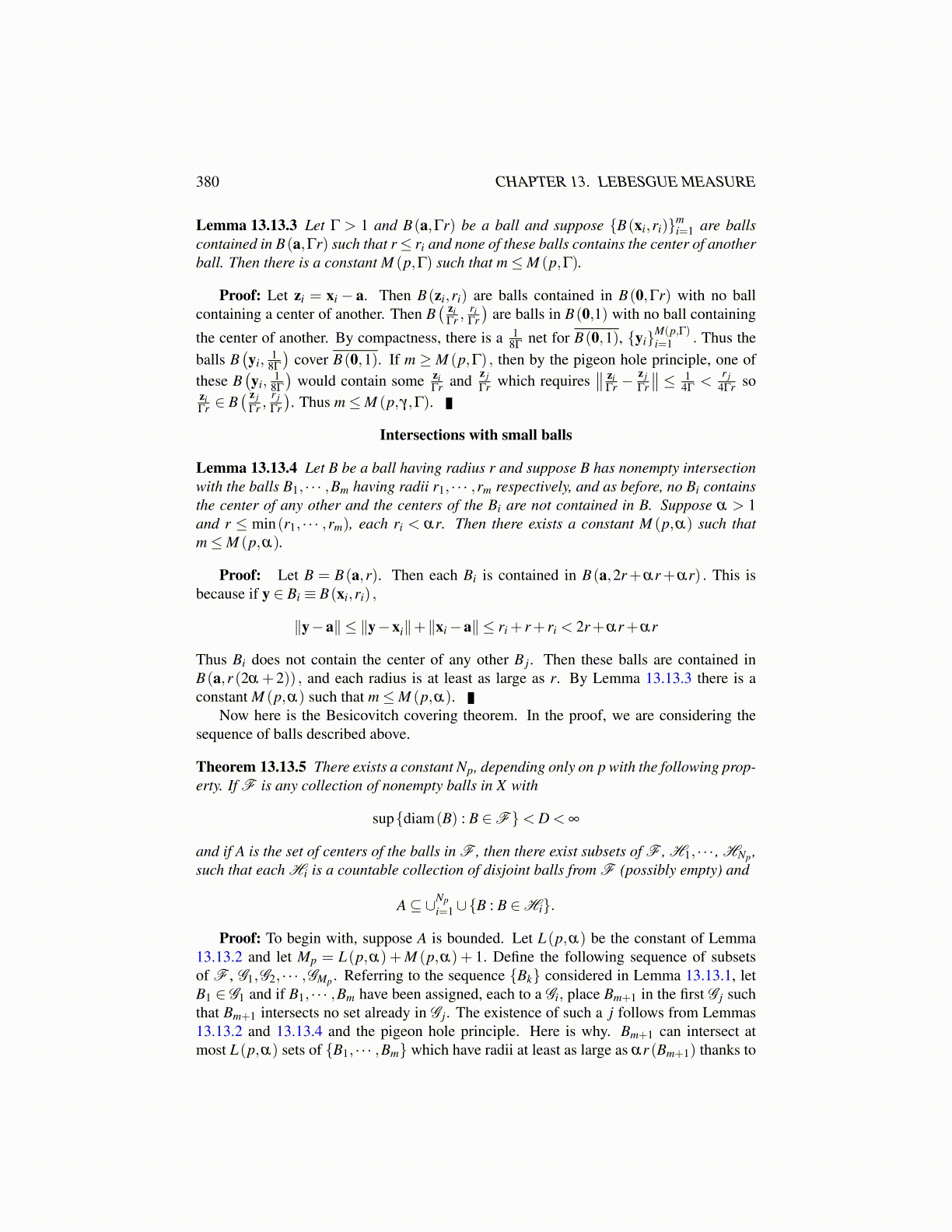
380 CHAPTER 13. LEBESGUE MEASURE
Lemma 13.13.3 Let Γ > 1 and B(a,Γr) be a ball and suppose {B(xi,ri)}mi=1 are balls
contained in B(a,Γr) such that r≤ ri and none of these balls contains the center of anotherball. Then there is a constant M (p,Γ) such that m≤M (p,Γ).
Proof: Let zi = xi − a. Then B(zi,ri) are balls contained in B(0,Γr) with no ballcontaining a center of another. Then B
( ziΓr ,
riΓr
)are balls in B(0,1) with no ball containing
the center of another. By compactness, there is a 18Γ
net for B(0,1), {yi}M(p,Γ)i=1 . Thus the
balls B(yi,
18Γ
)cover B(0,1). If m ≥ M (p,Γ) , then by the pigeon hole principle, one of
these B(yi,
18Γ
)would contain some zi
Γr and z jΓr which requires
∥∥ ziΓr −
z jΓr
∥∥ ≤ 14Γ
<r j
4Γr soziΓr ∈ B
( z jΓr ,
r jΓr
). Thus m≤M (p,γ,Γ).
Intersections with small balls
Lemma 13.13.4 Let B be a ball having radius r and suppose B has nonempty intersectionwith the balls B1, · · · ,Bm having radii r1, · · · ,rm respectively, and as before, no Bi containsthe center of any other and the centers of the Bi are not contained in B. Suppose α > 1and r ≤ min(r1, · · · ,rm), each ri < αr. Then there exists a constant M (p,α) such thatm≤M (p,α).
Proof: Let B = B(a,r). Then each Bi is contained in B(a,2r+αr+αr) . This isbecause if y ∈ Bi ≡ B(xi,ri) ,
∥y−a∥ ≤ ∥y−xi∥+∥xi−a∥ ≤ ri + r+ ri < 2r+αr+αr
Thus Bi does not contain the center of any other B j. Then these balls are contained inB(a,r (2α +2)) , and each radius is at least as large as r. By Lemma 13.13.3 there is aconstant M (p,α) such that m≤M (p,α).
Now here is the Besicovitch covering theorem. In the proof, we are considering thesequence of balls described above.
Theorem 13.13.5 There exists a constant Np, depending only on p with the following prop-erty. If F is any collection of nonempty balls in X with
sup{diam(B) : B ∈F}< D < ∞
and if A is the set of centers of the balls in F , then there exist subsets of F , H1, · · · , HNp ,such that each Hi is a countable collection of disjoint balls from F (possibly empty) and
A⊆ ∪Npi=1∪{B : B ∈Hi}.
Proof: To begin with, suppose A is bounded. Let L(p,α) be the constant of Lemma13.13.2 and let Mp = L(p,α) +M (p,α) + 1. Define the following sequence of subsetsof F , G1,G2, · · · ,GMp . Referring to the sequence {Bk} considered in Lemma 13.13.1, letB1 ∈ G1 and if B1, · · · ,Bm have been assigned, each to a Gi, place Bm+1 in the first G j suchthat Bm+1 intersects no set already in G j. The existence of such a j follows from Lemmas13.13.2 and 13.13.4 and the pigeon hole principle. Here is why. Bm+1 can intersect atmost L(p,α) sets of {B1, · · · ,Bm} which have radii at least as large as αr (Bm+1) thanks to